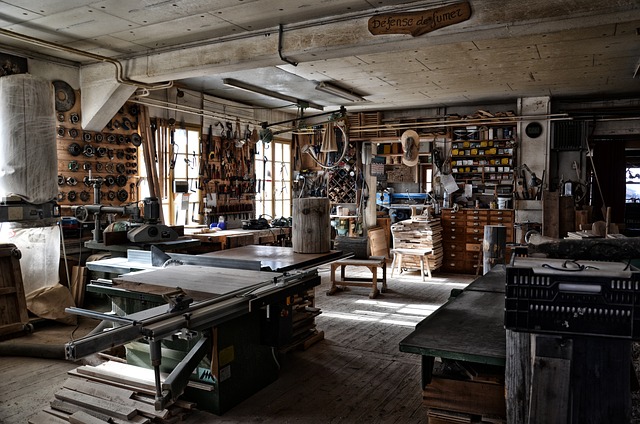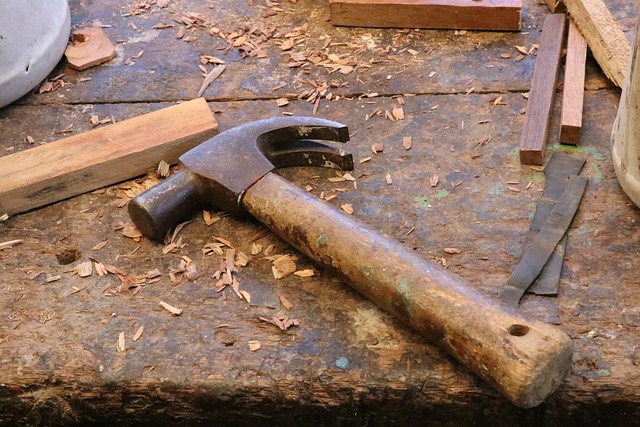When selecting wood, a carpenter's choice between hardwoods (oak, maple) for high-use items or softwoods (pine, cedar) for weather-resistant outdoor structures is crucial due to each wood's unique properties and resistance levels. Teak and mahogany are excellent choices for both indoor and outdoor use due to their moisture resistance. Carpenters must consider ease of working with the wood, its nail-holding capacity, and the desired finish. Proficiency in cutting, understanding tool selection (handsaws, circular saws), and maintaining safety gear is essential for carpentry success. Woodworkers value the versatility of wood as a medium that balances functionality with artistic expression. Precision measurement is foundational, with tools like tape measures and laser distance measurers used to ensure accuracy and prevent errors that could affect both aesthetics and structural integrity. Joints (dovetail, mortise and tenon) and fasteners (screws, nails, bolts) are carefully chosen based on the project's needs for both strength and visual appeal. A skilled carpenter integrates traditional joints with modern fastening techniques to create durable, high-quality woodwork that combines strength with a refined appearance.
Embark on a comprehensive journey into the craft of carpentry, where the transformation of raw timber into intricate pieces is both an art and a science. This article meticulously guides you through the essentials of selecting, cutting, shaping, and assembling wood for a wide array of projects. From mastering the precise art of cutting to understanding the significance of grain orientation and joint types, each step is detailed with practical tips, safety precautions, and innovative techniques suited for both indoor and outdoor applications. Whether you’re a seasoned carpenter or a novice eager to learn, this article serves as an indispensable resource for perfecting your woodworking skills and ensuring your projects stand out for their strength, beauty, and precision.
- Understanding Wood Selection for Carpentry Projects
- Mastering the Art of Cutting Wood: Techniques and Tools
- Exploring Various Shapes in Woodworking: Their Uses and How to Create Them
- The Importance of Measurement Precision in Carpentry
- Assembling Wood: Joints and Fasteners for Strength and Aesthetics
Understanding Wood Selection for Carpentry Projects

When embarking on carpentry projects, selecting the appropriate wood type is a pivotal decision that influences both the functionality and aesthetics of the final piece. A seasoned carpenter understands that each species of wood offers unique properties, ranging from strength and durability to grain patterns and color variations. For instance, hardwoods like oak and maple are favored for their resilience and sturdiness, making them suitable for furniture that will experience high levels of use. Conversely, softwoods such as pine and cedar, with their lighter weight and workability, are often chosen for constructing outdoor structures like decks and garden sheds where resistance to the elements is crucial.
Moreover, the intended purpose of the wood in the project must be considered. Woods like teak and mahogany are renowned for their natural resistance to moisture and decay, which makes them ideal for both indoor and outdoor applications. Meanwhile, softwoods such as fir and spruce, with their straight grains and easy nail-holding properties, are preferred in the construction of cabinet boxes and frames. A carpenter must also think about the wood’s texture and how it will finish; some woods accept stains and finishes differently than others, which can affect the end result’s visual appeal. Understanding these characteristics allows a carpenter to make informed decisions, ensuring that the selected wood not only meets the project’s requirements but also contributes to its longevity and beauty.
Mastering the Art of Cutting Wood: Techniques and Tools

mastering the art of cutting wood is a fundamental skill for any carpenter, as it lays the foundation for crafting everything from intricate furniture to robust construction components. The precision and angle at which one cuts can drastically alter the functionality and aesthetics of the final product. To achieve clean, accurate cuts, carpenters must be adept at using a variety of tools. A handsaw, for example, is versatile but requires a steady hand and proper technique to make straight or curved cuts. For more precise work, power tools like circular saws, jigsaws, and table saws are indispensable, offering control and speed that manual tools cannot match.
When selecting tools for cutting wood, the carpenter must consider the type of cut required, the material’s hardness, and the desired finish. A sharp blade is crucial for clean cuts; a dull one can tear the wood fibers, leading to splintering or an uneven edge. The choice between a crosscut saw for a fine, straight cut or a ripsaw for cutting along the grain becomes intuitive with experience. Safety measures are non-negotiable; proper attire, including safety glasses and hearing protection, should always be worn when operating power tools to prevent injury from dust, debris, or loud noises. Additionally, setting up the tool correctly and understanding its mechanisms will ensure efficient and safe cutting practices. By honing their skills with both hand and power tools, carpenters can produce precise cuts that serve as the building blocks for exceptional woodwork projects.
Exploring Various Shapes in Woodworking: Their Uses and How to Create Them

Woodworkers, both amateur and professional, often marvel at the versatility of wood as a material, thanks to its pliable nature that allows for an array of shapes and forms to be carved, shaped, and assembled. The art of carpentry is not merely about constructing functional pieces; it’s also about the creative process of transforming raw lumber into intricate designs that serve both aesthetic and practical purposes.
The most common shapes in woodworking include squares, rectangles, and circles, which are fundamental to creating boxes, benches, and tables. However, the craft extends far beyond these basic geometries. Carpenters often experiment with hexagons for beehives or honey containers, octagonal forms for storage bins or toolboxes due to their efficient use of space, and even more complex shapes like ovals or custom curves for furniture that adds an element of elegance and uniqueness to any interior. To create these diverse shapes, carpenters employ a variety of tools such as saws, chisels, and sanding equipment. Mastery of these tools is essential for precision and safety in the workshop. Additionally, understanding the wood grain and its direction is crucial for achieving clean cuts and minimizing splintering or warping. By using templates, jigs, or freehand techniques with a sharp blade, carpenters can bring to life virtually any design they envision, making each project not just a functional piece but also a testament to the craftsmanship and artistry of woodworking.
The Importance of Measurement Precision in Carpentry

When a carpenter approaches a new project, the foundation of their work lies in precise measurement. Accuracy in this step is paramount because it directly influences the fit and function of the final piece. A slight miscalculation can lead to a project that doesn’t align properly, or worse, one that’s structurally unsound. Carpenters rely on a variety of tools such as tape measures, rulers, and laser distance measurers to ensure measurements are exact. The use of these tools, combined with the carpenter’s experience and keen eye, allows for the creation of components that fit together seamlessly. This precision is crucial not only for aesthetic reasons but also for the safety and longevity of the woodwork. In cabinetry, for instance, where drawers slide in and out, the exactness of the measurements dictates the smooth operation of these features. Similarly, in the construction of a staircase, precise angles and lengths are necessary to ensure stability and adherence to building codes. Therefore, the carpenter’s commitment to measurement precision is a testament to their dedication to quality craftsmanship and safety in every project they undertake.
Assembling Wood: Joints and Fasteners for Strength and Aesthetics

When assembling wood for various projects, a skilled carpenter employs a blend of joints and fasteners that serve both functional and aesthetic purposes. The selection of joints is crucial in ensuring the strength and integrity of the wooden structure. Butternut, maple, or pine, depending on the project’s requirements, are expertly joined together using techniques such as dovetail joints for fine furniture pieces, where precision is paramount, or mortise and tenon joints for larger structures that require both durability and alignment. The carpenter meticulously fits these components, ensuring a seamless union without the need for excessive adhesive.
In complement to traditional joints, modern fasteners are often integrated to enhance stability and reliability. Carpenters today have access to an array of choices, including screws, nails, and bolts, each with its own advantages. For example, screws provide a strong hold without compromising the wood’s surface, while metal brackets and plates can be concealed within joints for a clean finish that appeals to both function and design-oriented clients. The use of pilot holes and counter-sinking ensures that any visible fastener head is flush with the wood’s face, creating an aesthetically pleasing appearance that is characteristic of high-quality carpentry work. Through this careful application of joints and fasteners, carpenters craft pieces that stand the test of time, both in use and beauty.
In conclusion, embarking on carpentry projects requires a comprehensive understanding of wood selection, precise cutting techniques, diverse woodworking shapes, and accurate measurements. By mastering these skills, both novice and seasoned carpenters can assemble pieces with strength and aesthetic appeal. Whether your passion lies in crafting furniture, building custom joinery, or simply creating functional items for your home, the knowledge of appropriate tools and methods is indispensable. With practice and attention to detail, anyone can transform raw wood into intricate works of art that stand the test of time. Embrace the hands-on nature of carpentry and let your creativity take shape in the tangible beauty of wood.
